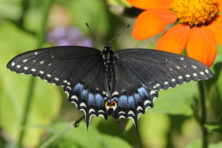Door to Nature: A Season of Butterflies
- Share
- Tweet
- Pin
- Share

July is one of the best months to learn about butterflies in our area. The numbers so far have not been as high as during other summers because of the colder-than-normal spring weather, but now with July’s heat wave, the numbers are increasing. Monarchs showed up along the Lake Michigan shores sooner than inland, where I live.
Recently, I’ve noticed many yellow tiger swallowtail butterflies, of which there are two main species. The easterns have a wider wingspan of three and a half to five and a half inches; show more yellow color; and have two broods. They’re found mostly in the southern end of the state. The Canadian tiger swallowtail has wider black bands and a three- to four-inch wingspan, and it has just one brood. It’s more common in the northern two-thirds of Wisconsin.
One of my favorite field guides is Butterflies of the North Woods by Larry Weber. It covers Michigan, Wisconsin and Minnesota. Helpful features include the area in the Upper Midwest where the species can be found and the months when they’re flying.
It’s difficult to imagine anything more exciting in nature than watching a butterfly emerge from its chrysalis or having an adult land on your outstretched hand. Monarchs are one of the species that some people help to go through their life cycle. A friend collects tiny caterpillars from milkweed plants and encases them with many milkweed leaves.
It’s fascinating to see the caterpillars go through several instars, to the time when they are mature and form a chrysalis. This intermediate stage lasts for about two weeks, depending on the temperature. The newly formed chrysalis is jade green and changes color as the monarch develops. Then all of a sudden, its thin, plastic-like outer shell breaks open, and the new monarch butterfly comes out, or ecloses.
The new butterfly must slowly move its wings to pump fluids from its body to gradually expand its wings to their full size. The monarchs that eclose near the end of the summer are slightly bigger than the earlier ones, and that larger size aids them on their journey to the mountains of Mexico, where they spend the winter.
The feet of these fragile creatures function similarly to the human tongue in that they help the butterflies to taste. When, for example, their feet come into contact with nectar on a flower or the salts of a person’s skin, their proboscis (pro-BOS-sis) uncoils and reaches down to touch that material.
This amazing organ is the tongue or beak of the butterfly. Through this slender, flatly coiled tube, it sucks liquids into its mouth. When it’s not in use, it’s wound in a spiral.
The art of gently catching, enjoying and releasing butterflies has a lot to say for it. Robert Michael Pyle, one of my favorite butterfly experts and writers, said, “Butterflies are never boring” and “No butterfly lover ever started a war, to my knowledge.”
In trying to convince a birdwatcher friend to become a butterfly watcher, Pyle said, “Unlike birds, they [butterflies] begin their days’ activities at the very civilized hour of eight or nine o’clock.”
Two of my favorite midsummer butterfly groups – the wood nymphs and the satyrs – are now on the wing. Check a field guide to learn about some that appear in this region, including the eyed brown, little wood satyr, northern pearly eye and clouded wood nymph.
The little wood satyr likes sunlit trails that meander in open wooded spaces. I see them along the driveway as I walk to the mailbox. How deceiving their slow, loping flight can be when it comes to catching one in a net. They can feint, bob and weave their way through grasses and shrubs, so instead of having weak, jerky, dancing flight, they become skillful dodgers when alarmed.
Common sulphur butterflies are noticeable along grassy roadsides in the county’s agricultural areas. Their yellow color may be why this species was thought to originate the name “butterfly.” Caterpillars of the common sulphur feed mainly on clover, alfalfa and vetches.
Butterflies are the perfect vehicle for learning about and experiencing the summer world around us. Sharpen your powers of observation, and learn more about the native plants that butterflies prefer and need in their life cycles. In doing so, you will enjoy new, exciting experiences and increasingly feel that you’re a genuine partner in nature with other wild creatures large and small.
Butterflies are light and delicate, yet they can be powerful, mighty reminders of how fragile our planet Earth really is.




